The matrix organization is a beacon of innovation in advanced project management. It skillfully weaves together functional and project-driven structures to enhance the agility and responsiveness of the organization in today’s volatile business environment. This intricate architecture is designed to navigate the tangle of modern business challenges, enabling a flexible posture that enables organizations to pivot quickly in response to changing market dynamics and emerging opportunities.
The matrix design takes organizational agility and operational efficiency to new heights by seamlessly blending the robustness of functional departments with the agility of project-based teams. This strategic convergence is particularly important in an industry marked by rapid advances in technology and volatile markets. It places matrix organization at the forefront of the adaptability and strategic foresight that is required.
What is a Matrix Organization?
The concept of a matrix organization extends beyond the traditional dual reporting system. It is the embodiment of a strategic design that aims to optimize operational agility and foster innovation in a dynamic business landscape.
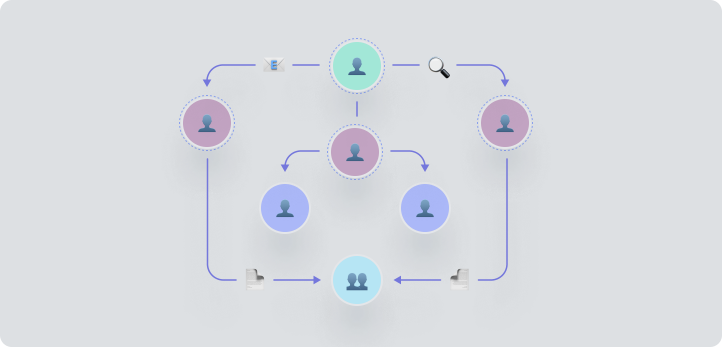
In this model, employees navigate dual loyalties. They are aligned with both functional departments and cross-functional project teams. This dual reporting mechanism not only fosters a culture of rapid adaptability and continuous innovation. It also cultivates a workforce with a broader perspective and more diverse skill sets.
Employees in a matrixed organization develop a diverse repertoire of skills by participating in a variety of projects while maintaining their functional expertise. As a result, the organization has a greater capacity for complex problem solving and the development of creative solutions.
How do Matrix Organizations work?
Sophisticated structural design characterizes matrix organization. They excel at combining the dual dimensions of functional expertise and project dynamics. The model’s signature dual reporting structure enables a smooth blend of strategic resource deployment and cross-functional collaboration. It allows people to contribute to multiple projects while maintaining their specialized roles.
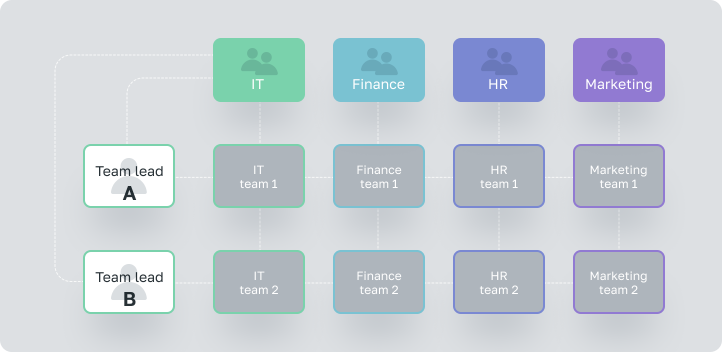
The principles of transparent communication and skilled conflict resolution not only require such a framework, but thrive on it. It ensures that a variety of perspectives are brought together in order to foster innovative solutions.
Matrix organization achieves unprecedented levels of flexibility and efficiency by strategically aligning resources and fostering a culture of collaboration. They navigate the complexities of today’s project landscape with agility and precision. In addition to maximizing specialized skills, this approach enables organizations to quickly adapt to changing market demands and position themselves at the forefront of innovation and problem solving.
Types of Matrix Management
Matrix management structures intricately delineate the authority and collaboration dynamics between functional and project management. These frameworks significantly influence organizational agility, project success, and cross-functional integration by shaping project execution strategies.
By defining the interaction between hierarchical and project-based leadership roles, matrix frameworks provide a sophisticated approach to managing resources. Here’s three types of matrix management:
Weak Matrix
Within a weak matrixed org framework, the primary source of power is centralized in the functional manager. This effectively forces Project Manager into supporting roles that are more closely related to facilitating and networking than to providing executive leadership.
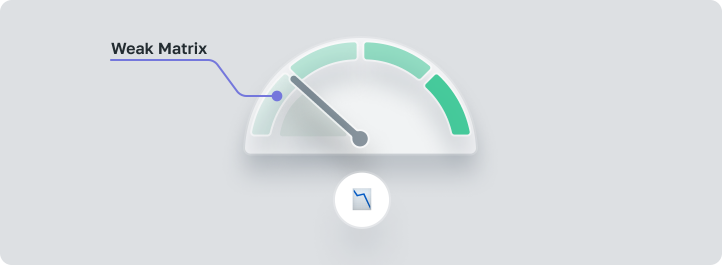
The paradigm reinforces the traditional hierarchical architecture inherent in functional areas. It limits the autonomy of project leaders in key areas such as command and control and the ability to make critical decisions. This structural predisposition requires project manager to operate skillfully within these constraints, using highly developed negotiation and influence skills to advocate for project needs and navigate the intricacies of this limited authority landscape to bring project initiatives to completion.
Balanced Matrix
The balanced matrix model is intricately designed to create a harmonious distribution of authority between the functional managers and the project manager. It strikes a critical balance that encourages each to work with the other.

This equal structure promotes a synergistic work environment. Responsibility and decision-making authority are shared equally, fostering a spirit of cooperation. It skillfully aligns the dual command system, ensuring that both project goals and functional imperatives are pursued with equal force. This increases organizational efficiency and goal alignment.
This model exemplifies how a balance of authority can lead to a dynamic, collaborative, and productive organizational atmosphere. It advances both project-specific and broader functional goals in tandem.
Strong Matrix
Within the framework of a highly matrixed organization, the project manager is provided with a significantly higher level of authority. This gives them the leverage to manage projects with considerable independence and to control how resources get deployed.
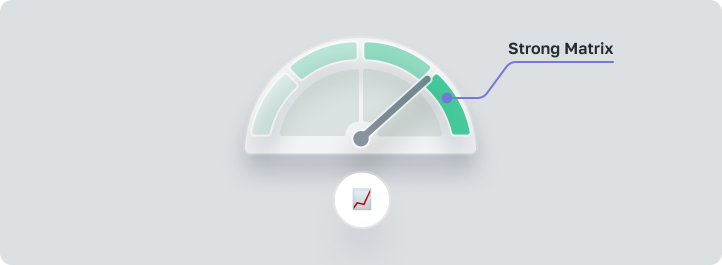
This enhanced status enables project manager to make decisions quickly and flexibly, prioritize tasks according to project goals, and lead their teams with enhanced leadership skills. Ensuring that the organization’s resources and strategic efforts are intensely focused on project execution and success is the essence of this structure.
It fosters an organizational culture that is naturally project-focused and agile. In addition to streamlining project delivery, this approach enhances the ability of the enterprise to adapt quickly to project needs and market changes. At the core of the organization’s operating paradigm is a project-centric mindset.
Advantages of the Matrix Organization Structure
The matrix organization, known for the distinctive blend of functional and project-oriented elements. This model is particularly effective for:
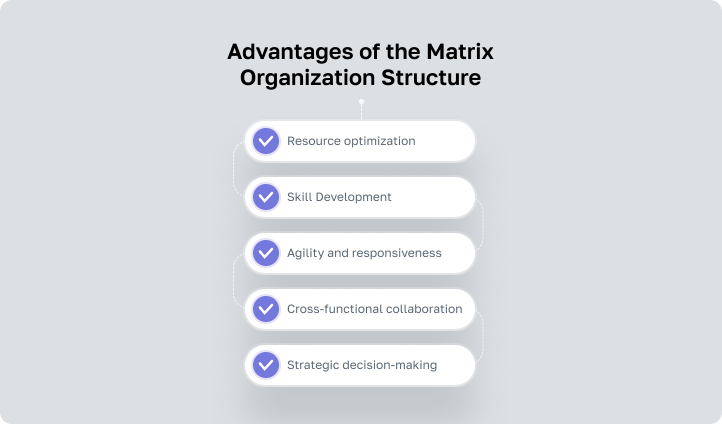
- Resource optimization: Enables seamless sharing of assets across multiple projects.
- Skill Development: Employees gain project experience that fosters professional development.
- Agility and responsiveness: Maintains the organization’s competitive edge by adapting to rapidly changing market conditions.
- Cross-functional collaboration: Working across traditional boundaries promotes a collaborative and innovative culture.
- Strategic decision-making: Dual reporting ensures decisions consider both functional expertise and project objectives.
These strengths make the matrix structure a powerful tool for organizations that operate in dynamic and complex environments.
Disadvantages of the Matrix Organization Structure
The matrix organizational structure promotes collaboration and flexibility. However, it also presents its own set of challenges:
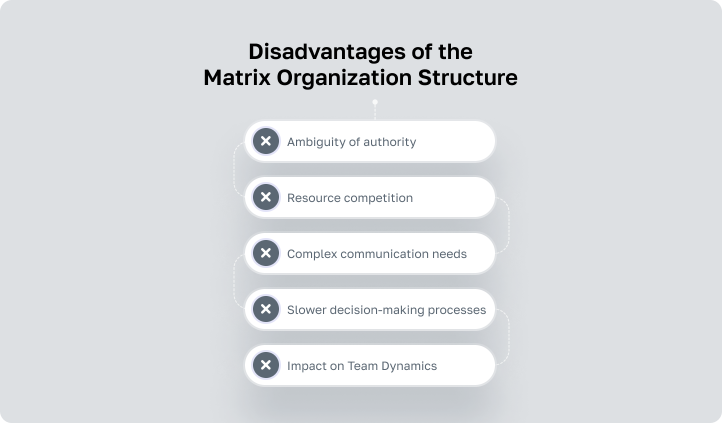
- Ambiguity of authority: Overlapping reporting lines can obscure authority and create uncertainty.
- Resource competition: Functional departments and project teams may be competing for resources.
- Complex communication needs: The complex structure requires sophisticated communication to avoid getting misaligned.
- Slower decision-making processes: The shared governance model can result in lengthy consensus-building efforts.
- Impact on Team Dynamics: Dual loyalty can strain team cohesion and affect overall morale. This underscores the need for skilled leadership to maintain a positive matrix work environment.
Examples of Matrix Org Structure
Adapting the matrix organizational structure across various sectors involves a nuanced approach tailored to each industry’s specific challenges and opportunities: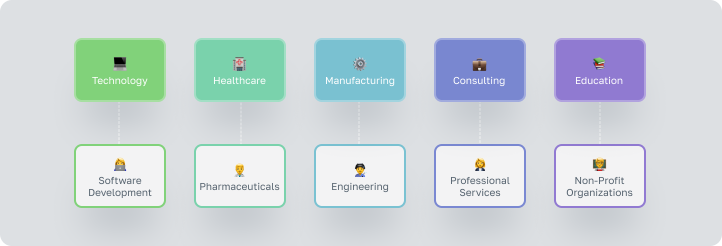
Example 1: Technology and Software Development
Matrix team structure emphasizes project-based focusing on product development, innovation, and rapid deployment, with functional roles supporting these teams in specialized areas like software engineering, quality assurance, and user experience design.
Example 2: Healthcare and Pharmaceuticals
Matrix structures in healthcare might combine research and development projects with functional expertise in clinical trials, regulatory compliance, and patient care practices to facilitate the development and distribution of healthcare solutions.
Example 3: Manufacturing and Engineering
These industries leverage matrix setups to integrate project teams for new product development or process enhancements with functional expertise in production, enhancing efficiency and product quality through collaborative efforts.
Example 4: Consulting and Professional Services
Consulting firms utilize matrix structures to orchestrate client projects across various domains (strategy, operations) while supporting these initiatives with robust functional departments for research and business development.
Example 5: Education and Non-Profit Organizations
In these fields, matrix structures facilitate the integration of project initiatives like curriculum development with functional support in finance and administration, promoting program effectiveness and resource optimization.
By customizing the matrix structure to fit the unique needs of each sector, organizations can effectively balance the dynamic demands of project management with the depth of functional expertise, driving success and innovation.
Improve the Matrix Structure with Project Management Tools
Here are five ways that project management tools can optimize the process of working with matrix structures, using Worksection as an example:
1 Centralized Information Hub
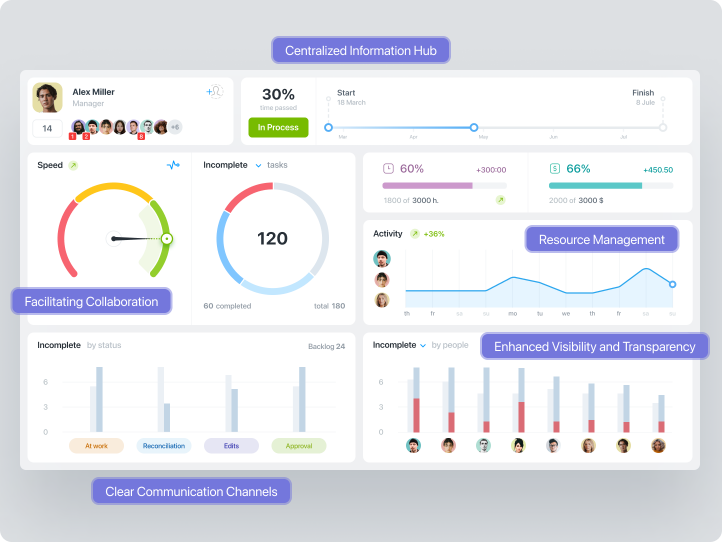
PM tools like Worksection act as a centralized platform where all project information, including tasks, schedules, and resources, is stored. This reduces the ambiguity surrounding task priorities and responsibilities, a common challenge in matrix organization.
2 Enhanced Visibility and Transparency
Dashboard and reporting features provide real-time visibility into project progress and resource allocation. This transparency helps in balancing workloads and aligning priorities across different arms of the matrix structure, ensuring that projects do not suffer due to internal competition for resources.
3 Resource Management
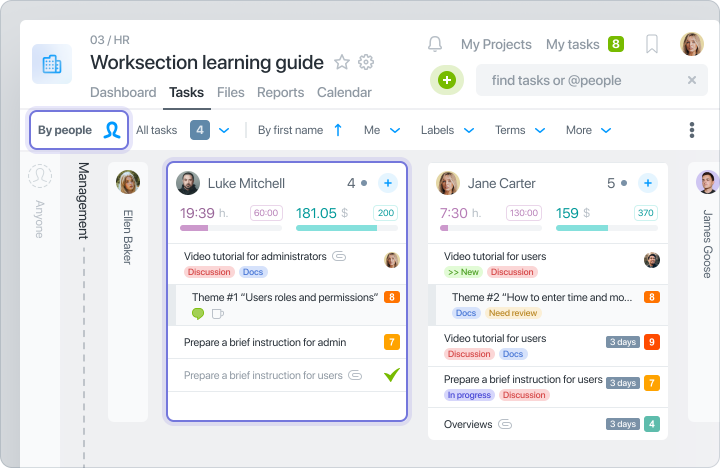
Effective resource allocation is critical in a matrix organization. Worksection enables managers to view team members’ workloads, helping in making informed decisions about task assignments based on availability and skill set, thus optimizing resource use.
4 Facilitating Collaboration
In a matrix setup, cross-functional collaboration is key. PM tools fosters this by allowing team members from different departments to collaborate on projects seamlessly. Its task management and team collaboration features ensure that everyone, regardless of their primary function, can contribute effectively to project goals.
5 Clear Communication Channels
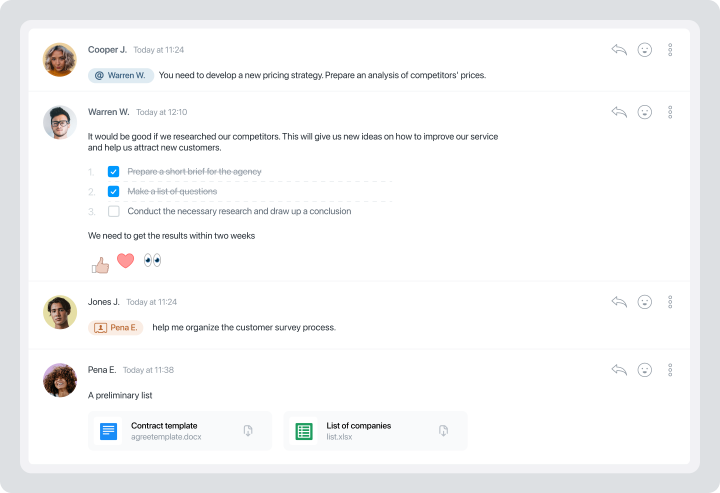
With features designed to streamline communication, Worksection ensures that messages reach the right people at the right time. This clarity is crucial in matrix structures where employees might receive conflicting directives from functional and project managers.
Conclusion
The matrix organizational structure is a dynamic and flexible framework. It provides organizations with a strategic advantage in navigating complex business landscapes. It promotes resource optimization, innovation, and adaptability by balancing the dual lines of command and fostering a collaborative environment across functional and project teams.
However, the success of a matrix structure relies on clear communication, effective conflict resolution, and strong leadership to overcome its inherent challenges. The matrix structure remains a powerful tool for organizations that want to remain agile and competitive in a rapidly changing world as industries continue to evolve.